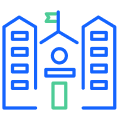5 Tips to protect against school cyber attacks
As school districts continue to embrace digital tools to enhance learning environments, the shadow of cyber threats grows larger, putting digital safety for students and staff at increased risk. According to recent data, the majority of schools have already encountered at least one cyber attack, with more than 1,600 reported cyber incidents happening between 2016-2022.
With incidents of cyber attacks on educational institutions on the rise, the safety of student and staff data has never been more at risk.
But what can be done to shield our schools from such vulnerabilities? In this article, we’ll explore the most common types of cyber attacks and what school districts can do to make their educational spaces safer and more resilient.
| Key Takeaways |
| Recognize common cyber threats like phishing, ransomware, and data breaches to better prepare and protect educational data.Clever’s cybersecurity blueprint is designed to systematically enhance your district’s cyber defenses.With essential tools like SSO, IDM, and MFA, school districts can create a multi-layered defense that enhances protection and streamlines user access. |
Common types of school cyber attacks
No place is immune to cyber threats—not even our schools. Below are the most common types of cyber attacks that schools face, alongside concerning statistics that highlight their impact:
- Phishing Attacks: Often the initial tactic used to breach school systems, these attacks deceive individuals into revealing sensitive information, setting the stage for more invasive threats. These types of attacks have more than quadrupled in the past year for educational institutions.
- Ransomware: In the last year, nearly 80% of educational institutions experienced this devastating form of malware which encrypts data and makes it inaccessible until a ransom is paid. The average recovery cost for K-12 schools from these ransomware attacks is approximately $750,000.
- Data Breaches: Since 2005, there have been at least 2,691 data breaches at schools and colleges in the U.S., compromising over 32 million student records, including grades and Social Security numbers. These breaches can happen by accident or on purpose and expose students to emotional, physical, and financial risks extending into their adult lives.
- DDoS (Distributed Denial of Service) Attacks: While these types of attacks are less prevalent, they can still cripple school networks by overwhelming them with traffic, leading to significant operational disruptions.
- Zero-Day Exploits: While more common in higher education, these attacks take advantage of previously unknown vulnerabilities in software before the developers have issued fixes. Schools often fall victim due to outdated systems and delayed patch management..
Additionally, the K-12 Cybersecurity Resource Center reported that at least 75% of all data breaches affecting U.S. public K-12 school districts have involved security incidents linked to school district vendors and partners.
The Clever Blueprint: How to protect against school cyber attacks
Due to the increasing frequency and sophistication of cyber threats targeting educational institutions, Clever has developed a cybersecurity blueprint that has five high-level security recommendations schools can take to protect their attack surface.
Even though each school district’s needs will be different, this blueprint can be used as the foundation for multiple levels of security. Here are the five recommended areas to focus on:
1. Secure identities and access
School districts manage hundreds, if not thousands, of accounts, each requiring different access levels to various edtech. That’s why it’s imperative to ensure these identities are secure and access is properly managed to protect against unauthorized data breaches.
We recommend:
- Facilitating secure, easy access through single sign-on and multi-factor authentication
- Use complex passphrases
- Regularly review and remove unused accounts
- Restrict user privileges to only what’s necessary for their role
2. Protect devices
Keeping your devices protected is just as important as managing the users who access them. Every device that connects to a school’s network can be a potential entry point for cyber threats. Keeping school computers and tablets safe from threats is crucial for maintaining a safe learning environment.
To keep your devices secure, we recommend:
- Implementing a secure login process
- Using comprehensive security solutions to protect endpoints
- Regularly updating software to close security gaps
3. Proactively manage vendors
As we bring more technology into our schools, keeping a close eye on our tech partners is key. After all, a significant number of breaches are linked to third-party vendors. That’s why it’s vital to stay on top of managing these relationships.
Here’s what our security experts recommend:
- Maintain a current list of all active vendors
- Develop thorough procedures for evaluating and onboarding new technology partners
- Choose edtech vendors that make cybersecurity a priority
4. Plan for recovery
Preparing for the possibility of cyber incidents is as critical as the preventive measures. Despite following the best security practices, there’s still a chance of experiencing a cyber attack. Having a solid plan in place can help you minimize disruptions, reduce downtime, and quickly restore educational operations.
To create a comprehensive recovery plan, we recommend:
- Developing and testing incident response plan
- Keep consistent backups of all critical data
- Isolate critical systems to limit the spread of breaches
5. Cultivate a security culture
Building a security-aware culture across the entire school community is key to sustaining defense against cyber threats. Since the human element is often the most vulnerable link in the security chain, schools should encourage everyone to engage with and uphold strong security practices.
To foster a vigilant security culture, our security experts recommend:
- Educating students, staff, and administrators about cybersecurity best practices
- Share updates on threats and vulnerabilities
- Regularly reinforce security practices with continuous training
Essential security solutions to strengthen your defenses
At Clever, we understand that every school district faces unique challenges in securing its digital environment. Our suite of security solutions is tailored to simplify the process of strengthening your cybersecurity framework, while accommodating the unique needs of your educational environment.
Here are three essential tools from Clever that help secure your data and systems:
Single Sign-On (Clever SSO)

Clever Single Sign-On (SSO) is a secure authentication method that allows users—whether students, teachers, or administrators—to access multiple applications with a single set of credentials.
By eliminating the need to manage multiple passwords, this method helps avoid common insecure practices like password reuse or the creation of weak passwords. Additionally, SSO centralizes authentication processes, making it easier to enforce strong password policies and access controls across all integrated applications. Learn more about Clever SSO for schools.
Identity Management (Clever IDM)

Identity Management (IDM) is essential for streamlining the process of managing user identities throughout your school district. With Clever IDM, user accounts are automatically created and deactivated based on the user data from the district’s Student Information System (SIS) or Human Resources System (HRIS).
IDM simplifies centralized password management, helping ensure every user has strong passwords for their essential accounts and can easily reset them right in Clever. This makes it easy to keep learning on track without any disruptions. Explore Clever’s IDM solution.
Multi-factor authentication (Clever Classroom MFA)
Multi-factor authentication (MFA) requires users to provide a second form of verification in addition to their username and password when logging in. This additional layer of protection helps prevent unauthorized access even if a user’s password is compromised.
By implementing Clever Classroom MFA, schools can significantly enhance the security of their digital environments, protecting sensitive data from unauthorized access and account takeovers.
The best part? It offers easy-to-use, student-friendly MFA methods that work well even for younger students who might not be able to type or use personal devices in school. Find out more about Clever Classroom MFA.
When these essential tools are combined, they allow districts to streamline access management and fortify defenses against increasingly sophisticated threats. To learn more about how these solutions can be implemented in your district, book a call with a Clever cybersecurity specialist or sign up for Clever today.

More to read

May 5, 2025
Making Student MFA Easy: Lessons from North KitsapNorth Kitsap made student logins safer and easier with Clever Classroom MFA—yes, even for little kids. With age-appropriate tools and strong support, students quickly adapted, and staff followed suit. The result? Better security without the hassle.

April 24, 2025
5 Common Cybersecurity Myths, Debunked by ExpertsExperts from Clever, Microsoft Education, InnovateEDU, and public schools debunk common cybersecurity myths that could put student accounts at risk.

April 14, 2025
Clever Substitute Access: Secure learning continues even when teachers are outDigital learning gives teachers and students many exciting ways to engage and learn. But what happens when a teacher is absent and a substitute is in charge?

















